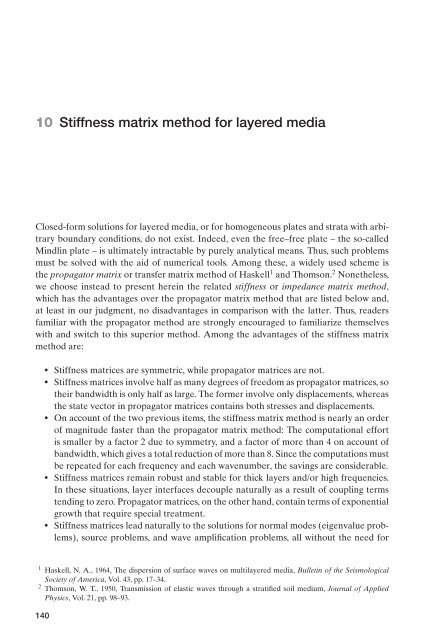Eduardo Kausel-Fundamental solutions in elastodynamics_ a compendium-Cambridge University Press (2006)
You also want an ePaper? Increase the reach of your titles
YUMPU automatically turns print PDFs into web optimized ePapers that Google loves.
10 Stiffness matrix method for layered media<br />
Closed-form <strong>solutions</strong> for layered media, or for homogeneous plates and strata with arbitrary<br />
boundary conditions, do not exist. Indeed, even the free–free plate – the so-called<br />
M<strong>in</strong>dl<strong>in</strong> plate – is ultimately <strong>in</strong>tractable by purely analytical means. Thus, such problems<br />
must be solved with the aid of numerical tools. Among these, a widely used scheme is<br />
the propagator matrix or transfer matrix method of Haskell 1 and Thomson. 2 Nonetheless,<br />
we choose <strong>in</strong>stead to present here<strong>in</strong> the related stiffness or impedance matrix method,<br />
which has the advantages over the propagator matrix method that are listed below and,<br />
at least <strong>in</strong> our judgment, no disadvantages <strong>in</strong> comparison with the latter. Thus, readers<br />
familiar with the propagator method are strongly encouraged to familiarize themselves<br />
with and switch to this superior method. Among the advantages of the stiffness matrix<br />
method are:<br />
Stiffness matrices are symmetric, while propagator matrices are not.<br />
Stiffness matrices <strong>in</strong>volve half as many degrees of freedom as propagator matrices, so<br />
their bandwidth is only half as large. The former <strong>in</strong>volve only displacements, whereas<br />
the state vector <strong>in</strong> propagator matrices conta<strong>in</strong>s both stresses and displacements.<br />
On account of the two previous items, the stiffness matrix method is nearly an order<br />
of magnitude faster than the propagator matrix method: The computational effort<br />
is smaller by a factor 2 due to symmetry, and a factor of more than 4 on account of<br />
bandwidth, which gives a total reduction of more than 8. S<strong>in</strong>ce the computations must<br />
be repeated for each frequency and each wavenumber, the sav<strong>in</strong>gs are considerable.<br />
Stiffness matrices rema<strong>in</strong> robust and stable for thick layers and/or high frequencies.<br />
In these situations, layer <strong>in</strong>terfaces decouple naturally as a result of coupl<strong>in</strong>g terms<br />
tend<strong>in</strong>g to zero. Propagator matrices, on the other hand, conta<strong>in</strong> terms of exponential<br />
growth that require special treatment.<br />
Stiffness matrices lead naturally to the <strong>solutions</strong> for normal modes (eigenvalue problems),<br />
source problems, and wave amplification problems, all without the need for<br />
1 Haskell, N. A., 1964, The dispersion of surface waves on multilayered media, Bullet<strong>in</strong> of the Seismological<br />
SocietyofAmerica, Vol. 43, pp. 17–34.<br />
2 Thomson, W. T., 1950, Transmission of elastic waves through a stratified soil medium, Journal of Applied<br />
Physics, Vol. 21, pp. 98–93.<br />
140



